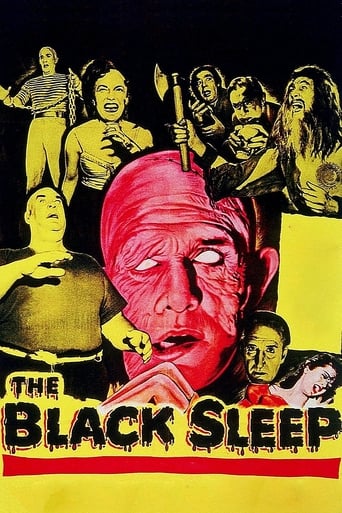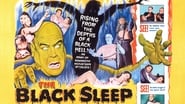calvinnme
This film has all of the great devices of the horror films of the 30's and 40's and keeps the tension and fright level up in the age of the atomic bomb, partly by being set in the 19th century. You've got Basil Rathbone as a doctor living in a medieval castle who is willing to do a hundred brain surgeries if necessary to bring his sleeping beauty wife back from a brain tumor induced coma. She really is too young for you Basil! You've got the mute "Mongo" played by Lon Chaney Jr. who had a paralysis cured by Basil's character, Dr. Cadman, but in the process lost his reason. Bela Lugosi is the mute servant Casimir, who really doesn't have too much to do. Then you have Daphne, a willing servant in Cadman's experiments who seems to be a bit in love with the doctor. And finally there is Laurie, Mongo's daughter, who is just assisting in the hope that Cadman will operate on "Mongo" again and restore his reason. He was once a brilliant physician and loving father.The protagonist, Dr. Ramsay, was sentenced to die for a murder he did not commit, and is rescued by Cadman to help in his operations by faking his natural death. Ramsay agrees to help Cadman not only out of gratitude, but because Cadman is mapping the human brain through a series of operations on cadavers. Or at least that's what he thinks he is doing.There are secret passage ways, the mysterious "black sleep" that simulates death and will actually cause death if the anecdote is not administered, and finally there is a basement full of maniacs that have an axe to grind with Doctor Cadman if they ever get loose. This one is a great homage to "The Black Cat", "The Raven", "The Old Dark House", and "Bride of Frankenstein" among others, which is strange when you think about it, because these are all Boris Karloff films and he is notably absent from this send up of the old Universal horrors. Very much worth your time and much better than the current rating reflects.
dougdoepke
Fairly classy horror feature. Of course, Rathbone, with his blade-like nose and parsed speech, could impart class to a Bugs Bunny cartoon. Here he's a mad doctor—what else—who's researching brains in order to cure his comatose wife. Meanwhile he's accumulated an all-star line-up of horror performers to help—a raving John Carradine, a ravaged Lon Chaney, a hulking Tor Johnson, a decrepit Bela Lugosi, and a slimy Akim Tamiroff. With a mob like this who needs special effects. Actually, most of the time is taken up with high-brow discussion of medical ethics. Naturally, Rathbone thinks ends justify means, while Rudley considers each life precious. Thus, unlike Rathbone, Rudley thinks research has its ethical limits. In fact, actor Rudley carries much of the narrative. A relative unknown, he gets lesser billing behind the all-stars. Nonetheless, he proves a very capable actor and foil for Rathbone. However, he's not the usual handsome hero and rescuer of damsels in distress. I'm not sure what the producers were reaching for here with the literate script and extended dialogue. Still, there are a few good jolting moments, like when a maniacal Carradine makes a first appearance. Then too, the movie came out at a time when Roger Corman's rubber monsters were dominating the screen, especially drive-ins. Anyway, it's a good chance to catch several horror icons in their declining years (Lugosi would pass just several months after), along with the incomparable Rathbone, a strikingly pretty Blair, and one of Hollywood's many unsung talents, Herbert Rudley.
MartinHafer
Beginning is a bit like "The Man They Could Not Hang"--innocent man condemned to death is spared by his doctor friend. It also is a bit like "The Man Who Lived Again"--both are Boris Karloff films from the 1930s. So, if you have a sense of déjà vu, this might be why.The film stars Basil Rathbone and Herbert Rudley. Rudley has been falsely accused of murder and is about to be executed. His 'friend', Rathbone, gives him a potion to make him appear dead--then instead of burying him, Rathbone will use him as an assistant in his brain research. What Rudley doesn't realize is that this research is being done on live humans--humans that Rathbone renders unconscious with his 'black sleep' formula. Unfortunately, Rathbone's plans for Rudley aren't all that altruistic--tune in and find the evil truth.This film has lots of appearances very horror notables--though most are not very satisfying, as their roles were very, very small. Along for the ride are Akim Tamiroff in a very creepy role--and the most complex of the guest stars. As for Lon Chaney, Jr. and Bela Lugosi, both have thankless non-speaking roles and are rather wasted. And, out of the blue, John Carradine appears near the end of the film...and then overacts wildly. And, along for the ride with him is Tor Johnson--of Ed Wood fame. I liked seeing all these guys--I just wish the script had given them more to say and do. It's like a great opportunity somewhat squandered.The film is entertaining--mostly because the plot is quite good and has a few nice twists. Unfortunately, however, there are also some moments with LOTS of cheese--most notably Carradine's bizarre performance. But the good well outweighs the bad and is fun.
m2mallory
From the opening shot of the Tower of London labeled "Newgate Prison" to the Scotland Yard inspector who feels obligated to reintroduce himself every time he walks into a scene, it is very hard to watch "The Black Sleep" with a straight face. Its main claims to fame are its large cast of horror veterans--Basil Rathbone, Bela Lugosi, Lon Chaney Jr., John Carradine, Tor Johnson, and, some say, Akim Tamiroff (who was really replacing Peter Lorre)--and the fact that this was Lugosi's last real film, shot after his release from self-imposed drug rehab. Lugosi dodders quite a bit, and looks unwell, but he does what he can with his non-role as a mute major-domo. Chaney, meanwhile, reprises his inarticulate, murderous brute routine that he had perfected through such other films as "The Black Castle" and "The Indestructible Man," while Carradine goes completely into the stratosphere as an insane religious fanatic who looks like he just escaped from the Bastille. Johnson is, well, Johnson, complete with the blind contact lenses he later wore in Ed Wood's epics. Rathbone, as the mad doctor who turns humans into monsters for love, is adequate, only really snapping into life in his scenes opposite Tamiroff, but the real lead of the film, in just about every scene, is the miscast Herbert Rudley as Rathbone's assistant, and the film's hero. In addition to being too old for the role of a medical student, Rudley was a very unsubtle actor who telegraphed every thought to the balcony...all right for comedy, but not so good here. He, Rathbone, and Carradine would all fare much better that same year in "The Court Jester." An even bigger villain than Rathbone's character, though, is the script by John C. Higgins, which must have been 300 pages long to include all the talk, talk, talk, talk. Every second on screen is talked-to-death and every plot point over-explained, which serves to make the film seem much longer than it is. Reginald LeBorg's "direction" accomplishes nothing but to record the endless dialogue, though he does manage to get in one trademark dream/montage sequence, reminiscent of some of his 1940s work at Universal. Despite the low budget the castle sets are quite impressive, but all that means is that seeing this cast against those sets makes watching a set of still photos of "The Black Sleep" as satisfying, if not more so, as sitting through the movie.






